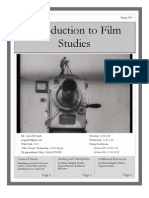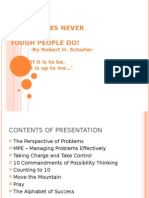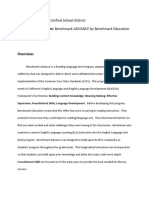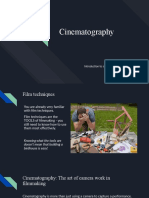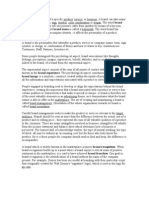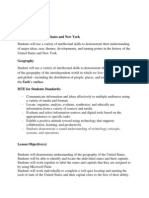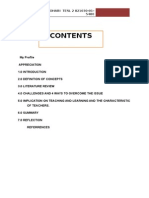Elements of Film
Elements of Film
Uploaded by
Ipsita BaratCopyright:
Available Formats
Elements of Film
Elements of Film
Uploaded by
Ipsita BaratOriginal Description:
Copyright
Available Formats
Share this document
Did you find this document useful?
Is this content inappropriate?
Copyright:
Available Formats
Elements of Film
Elements of Film
Uploaded by
Ipsita BaratCopyright:
Available Formats
Semester IV Film Analysis
Elements of a Film
STORY
Story- A meaningful sequence of events that produces some kind of aesthetic response.
The basic ingredients of a story are:
1. Idea - Story starts with an idea. A good film is one that is unified
By a single idea.
2. Plot -The pattern in which the story is dramatized.
3. Theme - A recurrent element of subject matter or emotional truth.
4. Crisis - A character in struggle is crisis.
5. Climax - That part of the story where the central character gets what he want or
doesn’t.
Story and Dramatic Construction
Dramatic construction – 3 Factors
1. Form.
2. Happenings in the story.
3. Spectators mind.
What is Drama?
To see drama in something is to perceive elements of conflict and to emotionally
respond to those elements of conflicts.
Story is actual happening. Dramatic construction is the way the happening is told.
Story is creation- dramatic construction is the result of techniques.
Various possible dramatic conflicts:
1. Man against man.
2. Man against society.
3. Man against nature.
4. Man against himself.
5. Society against society.
Toonskool Advanced Animation Academy
Semester IV Film Analysis
Various possible story structures:
1. Understandability - emotional understanding a preliminary demand.
2. Probability - True to life.
3. Identification - desire to participate in other peoples lives by
Understanding human conditions.
Requisites of a crisis development – Stages.
1. Undisturbed stage.
2. Disturbance.
3. Struggle.
4. Adjustment.
Story should have:
a) Beginning - Not a cow’s head on a goat’s body.
b) Middle - Lay all your eggs in this basket.
c) End - Triumph of logic - must be a fitting conclusion;
Not a forced Compromise.
Remember:
A story should begin properly; unfold logically, constantly increasing in
dramatic interest, reaches a skillfully constructed middle and thereafter ascending
towards a climax that transcends everything preceding it.
CONCEPT
A concept is a general idea of what the story is about. Effective concepts will not only
keep your story focused, they are excellent for telling others exactly what your story is
about.
A fully developed concept creates an interesting question and a result. "What happens
when a man and a high status woman marry and can't get along? They divorce and
become more miserable." A fully developed concept consists of things important to the
story: character, motivation, plot, subplot, conflict, climax, and resolution. It goes like
this:
Typically a character wants something, which brings him/her into conflict with a second
character. After a series of conflicts, which are handicapped by a subplot, and after a plot
twist, the final battle erupts and character one finally resolves the conflict. Additionally,
each main character should have a unique attribute that makes them interesting and is part
of the story.
Toonskool Advanced Animation Academy
Semester IV Film Analysis
SCRIPTING
A script is a written plan, Scripts can be original works or adaptations from existing
works such as novels.
The major components of a screenplay are
• Action – What is happening
• Dialogue – What we hear
Various stages of scripting:
1) Idea stage - Story outline.
2) Synopsis - Descriptive by nature. Description of characters, description of their
Involvement in the plot running to about 5 pages.
3) Treatment - a) Directive by nature.
b) Written in present tense.
c) Divided into sequences.
4) Script stages - a) Screenplay
i. Contains dialogues
ii. Sub-divided into scenes.
b) Shooting script
i. Divided into shots.
ii. Camera position.
Qualification of a Script Writer:
1) Must have knowledge of human mind.
2) Must have knowledge of human emotions.
3) Must have power of observation.
4) Camera eye.
5) Knowledge of the fundamentals of writing.
Importance of the Script:
For the film the
Screenwriter’s contribution is 65%
Director’s contribution is 25%
Actor’s contribution is 9%
Producer’s contribution is 1%
…. Billy Wilder.
Toonskool Advanced Animation Academy
Semester IV Film Analysis
Characterization in human Dimension:
Story must tell about man and his doings. Characterization is essential for a film.
Some obligatory facts must be communicated to life it from a nebulous state.
a) Age of the character.
b) Character’s occupation.
c) Character’s relation to other human beings.
d) Character of the human being is important.
The screenwriter must search for an expressive action to expose the character.
Smallest details can reveal deepest characterization. The indirect method of revealing the
characterization by the reaction of other people is effective.
Characterization can be revealed by contrast.
Essential attributes of characterization:
1) Constancy.
2) Consistency.
3) Must be revealed in stages –Must be gradual.
4) Characterization and story cannot exist separately.
Characterization should not be done by dialogue but revealed in action. Choose correct
combinations, which will result in action to reveal the character. Without good
characterization no film is interesting. Without interesting characters no film has really
much to say.
Ingredients in characterization:
1) Conflict - Balancing against forces of the right size.
2) Social stereotypes - Mixing contradictory stereotypes.
3) Grace or charisma.
Importance of characterization:
If the characters seem alive, so will the film even if the script is weak wrong
characterization can wreck a film.
Forward Movements:
This happens in the mind of the spectator. This is possible only:
a) If the viewer’s mind is not jilted to a halt every 2 minutes.
b) There should be continues development of plot and character.
c) Character must be allowed to grow not retreat.
d) It must give the viewer some food for thought.
The film must be made worth looking.
e) Scenes should appear to be segments pulled out of a continues existence not
as a skit staged for the entertainment of audience.
Toonskool Advanced Animation Academy
Semester IV Film Analysis
Points to be remembered by the scriptwriter:
1) His script must have dramatic construction.
2) Must have forward movement.
3) The strength of the script is characterization. Character should not
be one dimensional or cardboard character. Character must be
established cinematically by Exposition and development.
4) Grab the attention of the viewer as quickly as possible. It can be
accomplished by (a) scene of action of confrontation (b) presenting
an unusual character (c) Presenting a pictorially effective incident.
5) Stories are based on the following:
a) Heed – accepted basis of a good story.
b) Problem – need to eliminate physical danger.
d) Unusual situation – develop it to a conflict, deepen the mystery, give
the hero man-size obstacles to conquer. It is too easy it is not dramatic.
Satisfaction of need becomes the obstacle and furnished material
for its plot and character development.
Symbolism:
An equivalent between an idea and a fact is a symbol. An image for a thought.
Essentials of symbolism:
1) It must have a definite purpose
2) It must be obvious and easily understandable.
4) It must have universally of appeal.
5) It must arise out of the script material.
Importance of Symbols:
Speech can explain – symbol awakens
Language skips over the surface
Symbol strikes at its roots.
Types of symbolic communications:
1) Allegory – Highly obtrusive, almost riddle like.
2) Metaphor – an image for a thought.
3) Motif - communicating a recurrent image- or visual pattern a dominant feature in
composition.
4) Symbol – equivalent between an image and thought.
Epiphany:
Emotional manifestation. Sudden revelation of a thought or situation. A synthesis of
dialogue and emotion. Conveying the interior in this medium
Stream of consciousness techniques in film narration are also borrowed from literature.
Toonskool Advanced Animation Academy
Semester IV Film Analysis
Melodrama:
1. Melodrama is irrational illogical tragedy.
2. Play for the hero is one half of the melodrama. fear for the villain is the other half
of the melodrama.
3. A play characterized by highly sensational or romantic interest.
4. Melodrama has large emotions and dramatic excess.
5. There will be a gap between visual curiosity and useful consequences.
Points to remember:
1. Script is the literary foundation for the film.
2. Never use spoken dialogue to reveal action. Lengthy dialogue delays the action.
3. Titles must be attractive and related to the subject.
4. The essence of dramatic construction is the arousal of feeling.
5. Film making process takes place in 3 stages—writing, Filming and editing. The
first and the last are cerebral. The second is cerebral, physical and emotional.
6. You don’t have to show many things in a film but careful enough to show the
right thing.
DIALOGUE
What we hear
Purpose of dialogue:
1) Reveal a character.
2) Advance the story.
3) Get a laugh.
Caution: Writer must put the character’s thoughts not his own.
Performance
Difference between stage and screen acting:
1. Stage needs an exaggerated form of acting - Physical manifestation.
Film needs impressive gestures of life - subtle reaction.
2. Personal appeal is projected to the audience on stage. This should not be done on
film.
3. On stage one act. On screen one reacts. Reaction is a vital element in
communication. Good reaction can eliminate a lot of words.
4. Stage acting is stylized and emotionalized. Screen acting is naturalization.
5. On stage dialogue may be king. In film the thought behind the lines matter.
Toonskool Advanced Animation Academy
Semester IV Film Analysis
ACTOR
One who acts
Qualification for an Actor:
An actor should develop an ability to listen then only his response and reaction will
be spontaneous and not arbitrary. He should listen to the character and not the actor.
He must have the ability to make the audience feel an emotion. Ability to show
an emotion without putting on a demonstration.
Attributes of acting: a) Concentration
b) Sincerity
c) Relaxation
Types of Actor:
Exuberant Actor: They become interpreters. Researching the audience through himself
instead of the character. Whatever character he plays resembles him. He merely colors
the role. Object is to impress the audience quickly. One communicates to the audience;
not with the audience.
Indulgent: They become personality actors. Only talent he has is himself and so plays
only himself. Role must be tailor made to fit his personality. By this the scriptwriter’s
intention is completely eclipsed by the actors personal make-up. He the character by
himself.
Libretto Acting: Acting of conventionalized emotions. Stereotyped actions. An actor
who is predictable is a bad actor.
Method acting: Psychological motivation – art of experiencing rather than imitation. Not
the feeling itself but the symptoms of feeling. Deep identification with the character and
circumstances.
Basic elements that makes film acting unique:
1. Projection of internal conviction – performance must be believable and consistent
with the context of the film.
2. Physical performance – expressing the content of the role by body gestures.
Physically communicating the hidden facts of a character.
3. Intellectual communication - his intellectual and emotional responses must
emerge the life of the character and not from his talents as an actor.
Toonskool Advanced Animation Academy
Semester IV Film Analysis
TECHNIQUE
How the filmmaker renders and interprets his subject for the viewer is technique.
Technique must be used not abused. The dramatic context in the film should determine
the technique. Intention of the scriptwriter is important.
Action: it movement advances the plot it becomes action.
Remember: -
1. Pretty pictures are only an escape form the subject. Visual power.
2. Wollfflins theory
3. Director must depend on camera and action.
Various techniques used – techniques and subject matter must be fused.
1. Cutting – spatial equivalent and subject leap of thought.
2. Tracking – spatial growth of an idea or emotion.
3. Time lapse – visual illustration instead of verbal explanation.
4. Slow motion - to suggest a surrealistic dream or an entire emotion laden memory
running inside a characters mind.
5. Freezing – suggests timelessness.
6. Close up – facial expression matters.
7. Mid shot – behavior or gesture matters.
8. Long shot – general movement matters.
9. Duct angle – tilted camera angle indicating a delirious state.
10. High angle shot – should not be chosen for formal interest; it must have dramatic
logic.
11. Dissolve – sequence to sequence to bridge continuity links.
12. Fade – scene to scene – denotes lapse of time.
13. Cut shot to shot to intensify a single emotion.
14. Wipes – used to bridge two scenes without stopping the Tempe.
Sources of movement:
1. Subject movement
2. Camera movement
3. Subject and camera movement.
Where to place the camera:
1. Factor of convenience
2. Factor of editing – avoid jump
3. Factor of psychology – depends on the character
4. Factor of composition size of the image and movement matters.
Toonskool Advanced Animation Academy
Semester IV Film Analysis
LIGHTING AND CAMERA
Proper use of light can embellish and dramatise every object - Joseph Von Stenberg.
Major features of film lighting:
1. quality – a) hard ; b) soft.
2. direction- a) frontal ; b) side ; c) back ; d) top; e) under.
3. source – a) key ; b) fill.
Hollywood’s 3 point lighting :
1) key
2) fill
3) Backlighting.
Before setting up a director should consider the following:
1) Story motivation.
2) Logical and physical placement of characters
3) Psychological motivation of characters.
4) Continuity
5) Visual effect desired.
6) Emotional effect desired.
7) Editing plan – like use of cut ways, insert.
8) How much of the picture is to be revealed.
9) His desire to vary and change the area of audience interest.
10) Whether to use subjective or objective camera.
11) Time needed the shot.
12) He should use his drama sense and film senses.
Stationary shots: are by nature monotonous and dull. Whether intentional or the
director’s failure to give enough life and vitality. But moving the camera simply for
moving is wrong.
Choosing right movement – sources of movement:
1) Subject movement
2) Camera movement
3) Subject and camera movement
4) Picture to picture movement.
Set-up methods:
1. Bringing the actors to the camera
2. Bringing the camera to the actors.
Remember:
Toonskool Advanced Animation Academy
Semester IV Film Analysis
Shooting a teye-level is the dullest possible shot.position the camera either below or
above as the actors eyes must be seen.this is important.use the camera to make the point
of the scene. Never go for conscious compositions. They are futile bits of vanity.
Audience should never be aware of a cut or a camera movement.
Placement of the camera depens on :
1) factors of the convience
2) factor of the psychology
3) factor of editing
4) factor of composition.
Old method : complete coverage of a scene :
1) begin with a long shot
2) follow with a medium shot
3) then two over the shoulder shots
4) and two single close ups.
Camera movements:
Pivotal: 1) panning
2) Tilting.
Spatial: 1. Dolly
2. Tracking
3.crane.
The illusion of continuous flow of a action is important in film. Design to show A
continuous flow of action are:
The five cautions:
1) Cover shots
2) Overlapping action
3) Inserts
4) Cut-always
5) Reaction shots.
Camera angles :
Before choosing:
1) Spatial relationship to be determined
2) Position of the subject to be emphasized.
3) What is to be momentarily concealed
While choosing :
Toonskool Advanced Animation Academy
Semester IV Film Analysis
1) it should grow out of the scene not super – imposed upon.
2) unusual angles must be avoided.
Framing and composition :
Framing :
1) can isolate an important detail.
2) Can improve a scene by giving it a visual life it it is otherwise , by a
dramatic framing.
Composition : three factors involved in composition :
1) placement of objects and people within the frame.
2) Movement of objects and people within the frame
3) Movement of the frame itself.
Editing:
The last process in creative filmmaking is editing. Montage in association of ideas
rendered visual which gives their ultimate meaning.
Fundamentals of editing:
1. CU of man smiling
2. CU of gun going off
3. CU of a body falling
4. CU of a sad face.
If you put 1+2+3+4 it tells us that a happy man shooting someone who is mourned by the
third person. But if you put 4+2+3+1 it tells us that a sad man shooting someone to the
joy of a third man.
Importance of editing:
2. It is in the editing that the individual; creativeness of the director manifests itself.
3. It structures the sequence to produce a total work.
Kind of editing:
1. Form cutting or Ritterdam
2. Parallel cutting
Montage: juxtaposition of two or more separate units or images that when together
combine into large whole.
Types of montage:
2. Analytical montage – analyzing an event as to its hemetic content and synthesize
essential parts into an intensified screen event.
3. Idea associate montage – juxtaposing two seemingly dissociated images in order
to create a third concept.
Toonskool Advanced Animation Academy
Semester IV Film Analysis
Cutting:
Sudden cut creates a dynamic effect upon the viewer. Fast cutting creates an illusion of
increasing the tempo.
When to cut:
1) when action calls for a cut - when there is obvious motivation
2) cut to different angles for dramatic emphasis.
3) Cut at the end of a sentence not in the middle.
4) For reaction cut should be made a split second ahead of reaction of a
person.
When not to cut:
1) dont over cut series of fast cuts meaningless.
2) Don’t cut blindly without need.
3) For reaction cut should be made a split second ahead of reaction
of a person.
Rules of cutting:
1) Cut to improve a scene.
2) Cut in movement
3) Cutting must ensure that a scene begins and ends with continuing action.
4) Cut for proper values rather than proper matches.
5) Cut should afford a viewer a better look at the actor’s eyes.
6) When doubt about the exact footage to cut more and large not short.
7) Always place the extra footage in the beginning of the succeeding shot because fresh
is preferable to the stale.
SOUND/MUSIC
Sound is used extensively in filmmaking to enhance presentation, and is distinguished
into diegetic ("actual sound"), and non-diegetic sound:
• Diegetic sound: It is any sound where the source is visible on the screen, or is
implied to be present by the action of the film:
• Voices of characters;
• Sounds made by objects in the story; and
• Music, represented as coming from instruments in the story space.
• Music coming from reproduction devices such as record players, radios,
tape players etc.
• Non-diegetic sound: Also called "commentary sound", it is sound which is
represented as coming from a source outside the story space, ie. its source is
neither visible on the screen, nor has been implied to be present in the action:
• Narrator's commentary;
• Voice of God;
Toonskool Advanced Animation Academy
Semester IV Film Analysis
• Sound effect which is added for dramatic effect;
• Mood music; and
• Film Score
Non-diegetic sound plays a big role in creating atmosphere and mood within a film.
Sound effects
In motion picture and television production, a sound effect is a sound recorded and
presented to make a specific storytelling or creative point, without the use of dialogue or
music. The term often refers to a process, applied to a recording, without necessarily
referring to the recording itself. In professional motion picture and television production,
the segregations between recordings of dialogue, music, and sound effects can be quite
distinct, and it is important to understand that in such contexts, dialogue and music
recordings are never referred to as sound effects, though the processes applied to them,
such as reverberation or flanging, often are.
Function of background music:
2. To supply additional information
3. To intensify emotional content
4. To heighten dramatic effect
5. Music should enrich the visual.
Necessity of dramatic structures:
2. Designed to tell a story logically.
3. Designed to reveal insights into character
4. Designed to realize a theme in the climax
5. Designed to fulfill a story in the obligatory scene.
Objects of fundamental structures:
2. To assure conflict will occur in a logical interesting order.
3. To reveal the characters of men in action
4. To hold the interest of the viewer.
Toonskool Advanced Animation Academy
You might also like
- Leadership Self-Reflection EssayDocument3 pagesLeadership Self-Reflection EssayAngelNo ratings yet
- 2022 - 2023 - BLOCO - 1.D.P.11 - 17 - Documentary Storytelling Second Edition Making Stronger and More Dramatic Nonfiction Films by Sheila Curran Bernard Z-Liborg Cópia CópiaDocument7 pages2022 - 2023 - BLOCO - 1.D.P.11 - 17 - Documentary Storytelling Second Edition Making Stronger and More Dramatic Nonfiction Films by Sheila Curran Bernard Z-Liborg Cópia CópiaBernardo P. Matos0% (1)
- Anatomy of Film: Based On Text by Bernard F. DickDocument67 pagesAnatomy of Film: Based On Text by Bernard F. DickAndreea Ciobanu100% (1)
- Atomske Navike - Džejms KlirDocument14 pagesAtomske Navike - Džejms KlirDuško LjubanićNo ratings yet
- Course Syllabus Film and LiteratureDocument11 pagesCourse Syllabus Film and LiteratureFerdinand PagaranNo ratings yet
- Unit 36 Lighting Techniques LaaDocument13 pagesUnit 36 Lighting Techniques Laaapi-471521676100% (2)
- Intro To Film SyllabusDocument3 pagesIntro To Film SyllabusLbMcGrath100% (1)
- Guide Questions For Film AnalysisDocument1 pageGuide Questions For Film AnalysisJonathan Vincent TanNo ratings yet
- Christine Gledhill Ed Stardom Industry of Desire 1991 Introduction Pp. Xiii-XxDocument9 pagesChristine Gledhill Ed Stardom Industry of Desire 1991 Introduction Pp. Xiii-XxIpsita BaratNo ratings yet
- Tinto TheoryDocument4 pagesTinto TheoryMikeNo ratings yet
- Tough Times Never LastDocument48 pagesTough Times Never Lastapi-3834469100% (6)
- Pas Grice 1961 The Causal Theory of PerceptionDocument32 pagesPas Grice 1961 The Causal Theory of PerceptionstatusbelliNo ratings yet
- Benchmark Advance by Benchmark EducationDocument11 pagesBenchmark Advance by Benchmark Educationapi-449994247100% (1)
- CA 135 Film TheoryDocument14 pagesCA 135 Film TheoryGenevieve D'souzaNo ratings yet
- Motion, Time, and MemoryDocument22 pagesMotion, Time, and Memorygramsci03No ratings yet
- Shooting For Editing TechniquesDocument2 pagesShooting For Editing TechniquesbrettmaxNo ratings yet
- Deconstructing The SceneDocument7 pagesDeconstructing The ScenedkvyatNo ratings yet
- Cinematography - Introduction To Shot CompositionDocument30 pagesCinematography - Introduction To Shot CompositionHAFSA FAISALNo ratings yet
- Poetic DocumentaryDocument4 pagesPoetic DocumentaryDatuk CarlNo ratings yet
- Theories On The Documentary GenreDocument6 pagesTheories On The Documentary Genretemepetrakova100% (1)
- Postmodern Media General VariousDocument40 pagesPostmodern Media General VariousthdaleyNo ratings yet
- DocumentaryDocument30 pagesDocumentarycakeballsruleNo ratings yet
- Cinematic Techniques Terms and ExamplesDocument22 pagesCinematic Techniques Terms and ExamplesArkitek Jagz Cabuhat CapianNo ratings yet
- Chapter One: Understanding The Film Editing ProcessDocument8 pagesChapter One: Understanding The Film Editing ProcessKlucsik Gábor100% (1)
- Reading A FilmDocument4 pagesReading A FilmchrisvalentinoNo ratings yet
- Intro To Film GenreDocument15 pagesIntro To Film GenrePhil HentonNo ratings yet
- Surrealist CinemaDocument27 pagesSurrealist CinemaRebekah WalterNo ratings yet
- What A Documentary Is, After All - Carl PlantingaDocument14 pagesWhat A Documentary Is, After All - Carl PlantingaAdrián RomeroNo ratings yet
- How To Read A Film-J MonacoDocument38 pagesHow To Read A Film-J MonacobendjaniNo ratings yet
- Film AnalysisDocument2 pagesFilm AnalysisSuzanne SuttonNo ratings yet
- 6 Mise en Scene LessonDocument18 pages6 Mise en Scene Lessonapi-250301089No ratings yet
- Tomboy Presskit English PDFDocument11 pagesTomboy Presskit English PDFcarolina bmc0% (1)
- Avant Garde FilmDocument15 pagesAvant Garde FilmYaela GANo ratings yet
- Syllabus - Literature and Film - MA - 2012-2013 - ReloadedDocument8 pagesSyllabus - Literature and Film - MA - 2012-2013 - ReloadedElena Dana Ciocan CiudinNo ratings yet
- Badiou The False Movements of CinemaDocument6 pagesBadiou The False Movements of CinemaZac Settle100% (1)
- Roberta Nusim-Art Direction The Visual Language of Film (Teacher's Guide and Activities) PDFDocument8 pagesRoberta Nusim-Art Direction The Visual Language of Film (Teacher's Guide and Activities) PDFCésar NunesNo ratings yet
- Underexposed The Neglected Art of The CinematographerDocument27 pagesUnderexposed The Neglected Art of The Cinematographerraviitherising100% (1)
- Figure's of Film - Metaphor, Metonymy, and Repetition (Image & Narratove, 2014)Document12 pagesFigure's of Film - Metaphor, Metonymy, and Repetition (Image & Narratove, 2014)lexidoc100% (1)
- Film Genres and MovementsDocument4 pagesFilm Genres and MovementsSameera WeerasekaraNo ratings yet
- Narrative TheoriesDocument3 pagesNarrative TheoriesmclatchNo ratings yet
- Tittle An Investigation Into Nonlinear NarrativeDocument53 pagesTittle An Investigation Into Nonlinear NarrativeRoge ClashNo ratings yet
- F L E S: ILM Anguage and Lements of TyleDocument30 pagesF L E S: ILM Anguage and Lements of TyleSandesh MahajanNo ratings yet
- Aspects of Film MakingDocument4 pagesAspects of Film MakingVINAYAK CHOPPARINo ratings yet
- Cinematic Impressionism by VISIONARRIDocument0 pagesCinematic Impressionism by VISIONARRIMK AsyrafNo ratings yet
- Mise en SceneDocument18 pagesMise en SceneAlfian Krisna RamdhaniNo ratings yet
- Bord Well NarrationDocument23 pagesBord Well NarrationCatalina LeahuNo ratings yet
- Introduction To Film ArtDocument2 pagesIntroduction To Film ArtmuratakserNo ratings yet
- Types of Camera Shots Script PDFDocument2 pagesTypes of Camera Shots Script PDFRui ManuelNo ratings yet
- Haptic CInema Curation Pillsbury PDFDocument9 pagesHaptic CInema Curation Pillsbury PDFLeo ZhangNo ratings yet
- Angles in Film) : Step-By-Step Guide To Making A Shot ListDocument46 pagesAngles in Film) : Step-By-Step Guide To Making A Shot ListChristienne Jane SanvicenteNo ratings yet
- Aesthetics Ethics Cinema PDFDocument203 pagesAesthetics Ethics Cinema PDFMircea CiocalteiNo ratings yet
- Mise en SceneDocument27 pagesMise en Sceneapi-246403506No ratings yet
- L3 Genre OPM NewDocument20 pagesL3 Genre OPM NewJane KnightNo ratings yet
- Writing A Script: A Two-Column Script Is An Easy Way To Structure and Plan For YourDocument2 pagesWriting A Script: A Two-Column Script Is An Easy Way To Structure and Plan For YourJillianne Jill100% (1)
- What Is HorrorDocument5 pagesWhat Is Horrorapi-549630009No ratings yet
- Man With A Movie CameraDocument6 pagesMan With A Movie CameraMariusOdobașa0% (1)
- The Immersive Spectator: A Phenomenological HybridDocument18 pagesThe Immersive Spectator: A Phenomenological HybridMasson68100% (1)
- Photo EssayDocument1 pagePhoto EssayginomolfinoNo ratings yet
- Introduction To Film Mise-En-Scene NotesDocument2 pagesIntroduction To Film Mise-En-Scene NotesAayush SinhaNo ratings yet
- Film ProjectsDocument7 pagesFilm ProjectsmccabeandmrsmillerNo ratings yet
- The Gestalt PrinciplesDocument20 pagesThe Gestalt PrinciplesSujal BhattNo ratings yet
- Public Speaking Competence Assessment Rubric For Student SpeechesDocument1 pagePublic Speaking Competence Assessment Rubric For Student SpeechesOrlandoNo ratings yet
- Narrative Structure of The Minds of Billy Milligan Novel and Split FilmDocument5 pagesNarrative Structure of The Minds of Billy Milligan Novel and Split FilmMawar azzNo ratings yet
- Lesson Plan in English 10Document9 pagesLesson Plan in English 10Mary Jane CerenaNo ratings yet
- Identifying The Writer's Purpose: Module in English 10Document18 pagesIdentifying The Writer's Purpose: Module in English 10Lilah Blair100% (2)
- Identifying The Writer's Purpose: Module in English 10Document13 pagesIdentifying The Writer's Purpose: Module in English 10Airah Ballesteros100% (1)
- Ficci Frames 2017Document294 pagesFicci Frames 2017Ipsita BaratNo ratings yet
- SeminarDocument8 pagesSeminarIpsita BaratNo ratings yet
- The Meanings of BollywoodDocument15 pagesThe Meanings of BollywoodIpsita BaratNo ratings yet
- This Thing Called Bollywood: Madhava PrasadDocument6 pagesThis Thing Called Bollywood: Madhava PrasadIpsita BaratNo ratings yet
- BrandDocument3 pagesBrandIpsita BaratNo ratings yet
- Ge 3 Understanding The SelfDocument19 pagesGe 3 Understanding The SelfngayanritchiejohnNo ratings yet
- Lesson Plan: US States and CapitalsDocument3 pagesLesson Plan: US States and CapitalsSara Moutrane100% (1)
- Harrison Et Al - 2006 - AA Meta-AnalysisDocument24 pagesHarrison Et Al - 2006 - AA Meta-AnalysisCasey SmithNo ratings yet
- Needs Analysis WorksheetDocument3 pagesNeeds Analysis WorksheetJulia VelychkoNo ratings yet
- Lesson 2: Techniques in Selecting and Organizing InformationDocument25 pagesLesson 2: Techniques in Selecting and Organizing InformationMenjie BasmayorNo ratings yet
- Profed ReflectionDocument1 pageProfed ReflectionRhaymarc Owen ResadaNo ratings yet
- How To Avoid Communication BreakdownDocument3 pagesHow To Avoid Communication BreakdownVanessa abadNo ratings yet
- George Miller Experiment On Number 7 Phi Phenomenon 10012024 121026pm 29052024 054844pm 14062024 042728pmDocument14 pagesGeorge Miller Experiment On Number 7 Phi Phenomenon 10012024 121026pm 29052024 054844pm 14062024 042728pmSultan AwanNo ratings yet
- Physical DisabilityDocument18 pagesPhysical DisabilityjessaNo ratings yet
- Overview of The Program 14 May 2016Document28 pagesOverview of The Program 14 May 2016rkhanna1965No ratings yet
- The Real & Alleged Problems of Utilitarianism Author(s) : Richard B. Brandt Source: The Hastings Center Report, Apr., 1983, Vol. 13, No. 2 (Apr., 1983), Pp. 37-43 Published By: The Hastings CenterDocument8 pagesThe Real & Alleged Problems of Utilitarianism Author(s) : Richard B. Brandt Source: The Hastings Center Report, Apr., 1983, Vol. 13, No. 2 (Apr., 1983), Pp. 37-43 Published By: The Hastings Centern oNo ratings yet
- Report Writing: Definitions of ReportsDocument6 pagesReport Writing: Definitions of ReportsOsman KamaraNo ratings yet
- Edu Sem 8Document21 pagesEdu Sem 8Sitihajar Johari100% (1)
- Connecting Human Resources Management and Knowledge ManagementDocument13 pagesConnecting Human Resources Management and Knowledge ManagementJessica ValdiviesoNo ratings yet
- Sorting Exercise - Stress and Coping WITH STRESSDocument3 pagesSorting Exercise - Stress and Coping WITH STRESSdrtutu123No ratings yet
- Personal StatementDocument1 pagePersonal StatementfzrnaNo ratings yet
- Global Challenges in OBDocument14 pagesGlobal Challenges in OBrakum81No ratings yet
- Biological Science - Plant Growth and SurvivalDocument28 pagesBiological Science - Plant Growth and Survivalapi-419408664No ratings yet
- Individualized Learning Model of Gifted Children in Acceleration-Inclusion SettingDocument12 pagesIndividualized Learning Model of Gifted Children in Acceleration-Inclusion Settingsalman hussinNo ratings yet
- Lesson Plan: Characterization in The Great GatsbyDocument4 pagesLesson Plan: Characterization in The Great Gatsbyapi-341202813No ratings yet
- APA Reference ListDocument11 pagesAPA Reference ListGhulam MurtazaNo ratings yet
- MindfullnessDocument14 pagesMindfullnessPhysis Asclepius100% (2)
- Introduction To OBDocument14 pagesIntroduction To OBIshaan Sharma100% (1)
- Andrews2000 The Value of Reflective Practice: A Student Case StudyDocument3 pagesAndrews2000 The Value of Reflective Practice: A Student Case StudyNatassa FerentinouNo ratings yet






